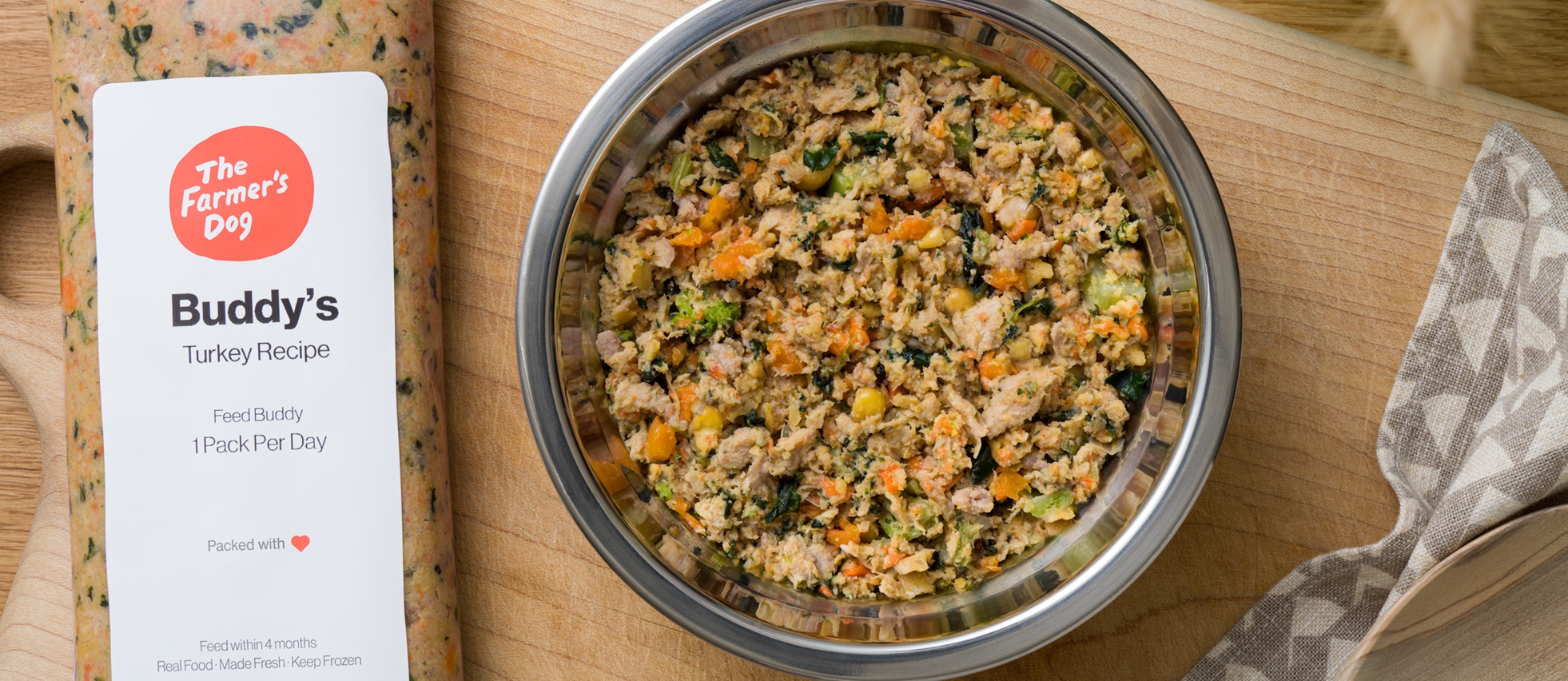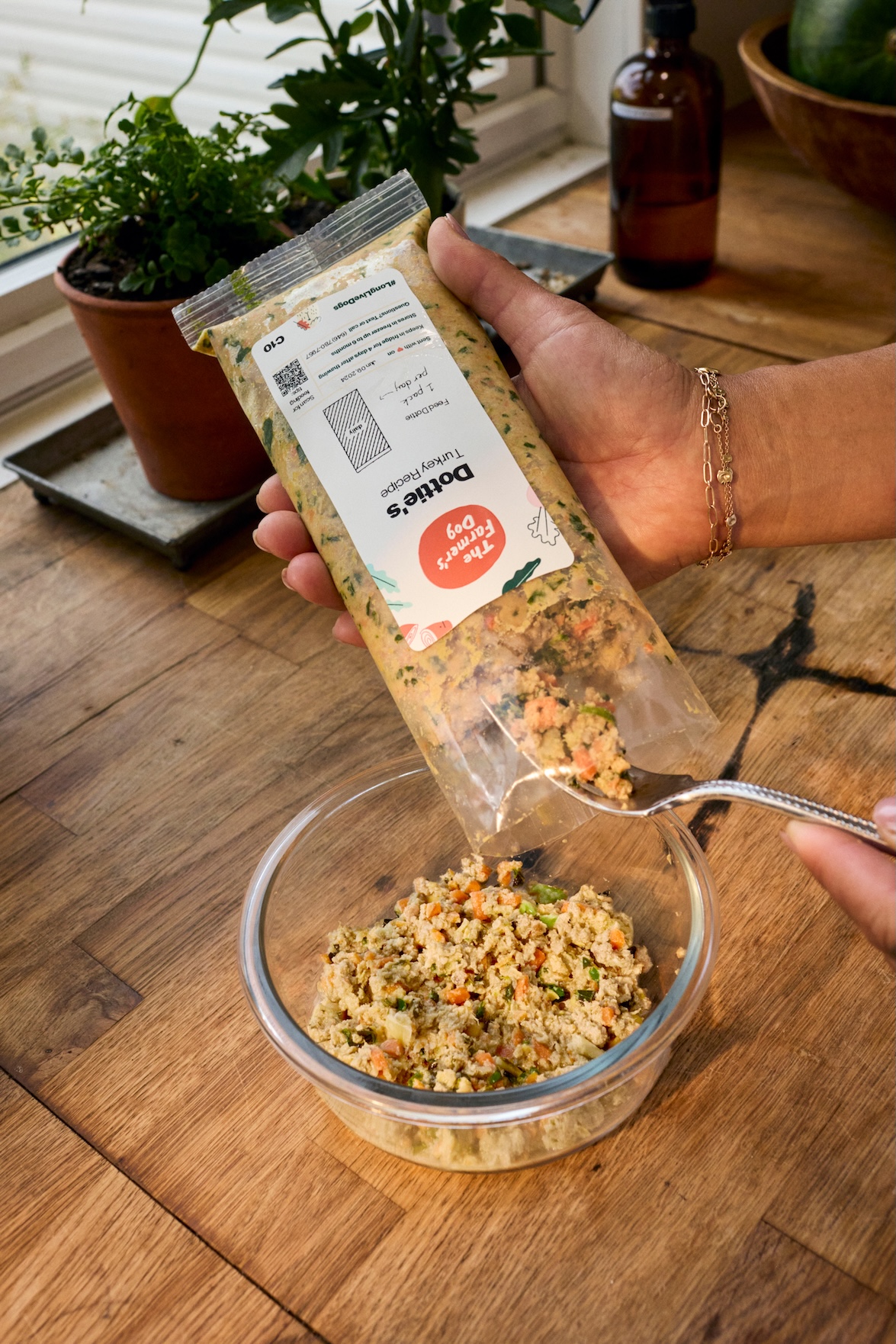When it comes to pet food, it’s whats inside that counts. When you get past the colorful label, the “improved!” graphic, the food photography, and the buzzwords—what is actually in the food in the package?
In your dog’s food, as in your own, ingredients do matter; they’re the building blocks of a daily diet. Every recipe from The Farmer’s Dog is made from fresh, whole, human-grade ingredients—that means food safe enough for a human to eat. Our recipes are carefully formulated by board-certified nutritionists to provide the right amount, and balance, of protein, fat, fiber, and vitamins and minerals to sustain your dog’s health and vitality over their whole life. Because our ingredients include real, whole meat and vegetables, and the ingredients are lightly cooked, the food is highly digestible, meaning your dog’s body can absorb, and use, the nutrients each ingredient provides.
Here’s a closer look at The Farmer’s Dog food ingredients (and keep reading for why even the highest-quality ingredients are only part of the story).
Meat
Whole muscle and organ meat make up at least 50% of our recipes.
Real meat is the cornerstone of a healthy diet for dogs. It’s full of the vital amino acids that sustain nearly every part of a dog’s body. Whole, gently cooked meat is proven to be more digestible than the highly processed “meal” powders and starchy fillers often used in kibble. Digestibility refers to how much of a food’s nutrients your dog is absorbing and using, and it’s a key pet-food quality metric.
Our recipes include meats like: whole beef, turkey, pork, and chicken; beef and chicken liver.
Vegetables
Vegetables may not be the first thing you think of when you think “dog food,” but green (and orange) vegetables provide important health benefits to dogs. They can provide your dog with an array of key vitamins and minerals, including phytonutrients, which are natural compounds found in plants that have disease-fighting potential. Veggies are also full of healthy fiber, and are a great source of hydration because of their high water content.
Our recipes include fresh vegetables like: carrots, green beans, Brussels sprouts, broccoli.
Fiber-rich foods
Fresh legumes like chickpeas, and vegetables like sweet potatoes provide vitamins and minerals as well as additional fiber, a key component of a dog’s diet—it helps maintain digestive health and a healthy gut, helps to regulate blood sugar levels, and leaves your dog feeling full for longer.
Our recipes include fiber-rich foods like: chickpeas, sweet potatoes, lentils.
Supplemental nutrients
To ensure our fresh recipes are nutritionally complete and balanced, we add human-grade supplemental nutrients like fish oil. It’s filled with immunity-boosting Omega-3s, and really tasty to dogs!

The other important ingredient: lower-heat cooking
Human-grade meat and vegetables provide a healthy foundation for dog-food recipes. But the ingredients themselves are only part of the story. The way those foods are cooked and handled can be considered another key ingredient in making a recipe healthy—or unhealthy. But you won’t find this ingredient on any pet-food label.
Ultra-processed dog foods like kibble typically start out with subpar ingredients—most kibble only qualifies as animal “feed,” so it contains leftovers from the process of making human food. And due to regulatory loopholes, other stuff can end up in there as well, including so-called 4D meats (diseased, disabled, dying, and dead animals) as long as they are turned into powder (the “meals” you see on pet food labels) via a process called rendering. But even if these dry foods advertise high-quality, or even human-grade, ingredients on their labels, the food in the bag is still subject to multiple rounds of high-pressure, high-heat processing that destroys a significant amount of the nutritional value the ingredients may have had (palatants and vitamins are sprayed on after the kibble bits have been processed). Further, most kibble is made in factories that aren’t subject to the same safety and quality standards that apply to human-grade food (so, again, even if any given ingredient is human-grade, the recipe can’t qualify as human-grade if it was made in a pet-food facility to the standards of animal feed).
The Farmer’s Dog food is gently cooked at a relatively low heat—a temperature high enough to kill potential pathogens but low enough to preserve the nutritional integrity of those good ingredients. And recipes are cooked in a human-food facility, governed by human-food standards.
So, any ingredient list should be viewed in the context of how, and where, the food was made.
Pet-food ingredients and marketing
The quality of our ingredients is core to our product—we use human-grade meat and vegetables, and we couldn’t be prouder of the level of care that goes into every component of every recipe. But you won’t find us splashing ingredient names on our packaging or in our ads. You also won’t see us leading with words like “superfoods” or “natural”—even though our recipes are chock full of foods that qualify as super, and our food is a more natural option than anything sitting in a bag on a store shelf.
Slapping the latest ingredient or nutritional buzzword on a label is a telltale sign of a pet-food industry marketing gimmick. The reality is, standard dry pet food has hardly changed since the invention of extrusion in the 1950s. But pet-food marketing changes all the time to reflect trends in human-food culture (think paleo diets when you see “ancestral” on a pet-food bag).
Broccoli is great for dogs. So are Brussels sprouts. And liver. And fish oil. But no one ingredient should be the big selling point of a diet. Our recipes are formulated so that all the ingredients work together to provide exactly what dogs need, based on veterinary nutrition science.
Visit The Farmer’s Dog to learn more about our recipes, and a fresh-food plan for your dog.




